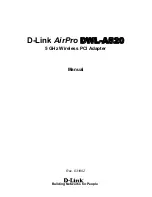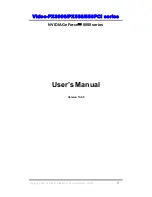
SERIES PMC440 PCI MEZZANINE CARD
32-CHANNEL ISOLATED DIGITAL INPUT MODULE
___________________________________________________________________________________________
- 2 -
The information contained in this manual is subject to change
without notice. Acromag, Inc. makes no warranty of any kind with
regard to this material, including, but not limited to, the implied
warranties of merchantability and fitness for a particular purpose.
Further, Acromag, Inc. assumes no responsibility for any errors that
may appear in this manual and makes no commitment to update, or
keep current, the information contained in this manual. No part of
this manual may be copied or reproduced in any form, without the
prior written consent of Acromag, Inc.
Table of Contents
Page
1.0 GENERAL INFORMATION...............................................
2
KEY PMC440 FEATURES................................................
2
PCI MEZZANINE CARD INTERFACE FEATURES.........
3
SIGNAL INTERFACE PRODUCTS..................................
3
PMC MODULE ActiveX CONTROL SOFTWARE............
3
PMC MODULE VxWORKS SOFTWARE………..............
3
2.0 PREPARATION FOR USE................................................
3
UNPACKING AND INSPECTION.....................................
3
CARD CAGE CONSIDERATIONS...................................
3
BOARD CONFIGURATION..............................................
3
CONNECTORS.................................................................
4
Front Panel Field I/O Connector P1...............................
4
Noise and Grounding Considerations.............................
4
PCI Local Bus Connector ........................………...........
4
3.0 PROGRAMMING INFORMATION....................................
5
PCI CONFIGURATION ADDRESS SPACE……...……...
5
CONFIGURATION REGISTERS……………...…………..
5
MEMORY MAP…..............................................................
5
Standard (Default) Mode Memory Map...........................
6
Enhanced Mode Memory Maps......................................
6
REGISTER DEFINITIONS................................................
7
THE EFFECT OF RESET.................................................
10
PMC440 PROGRAMMING CONSIDERATIONS..........…
11
Basic Input Operation.....................................................
11
Enhanced Operating Mode.............................................
11
Event Sensing................................................................
11
Change-Of-State Detection............................................
11
Debounce Control..........................................................
11
Interrupt Generation.......................................................
12
Programming Example...................................................
12
4.0 THEORY OF OPERATION...............................................
13
PMC440 OPERATION......................................................
13
PMC INTERFACE LOGIC….............................................
13
PMC MODULE SOFTWARE............................................
14
5.0 SERVICE AND REPAIR....................................................
14
SERVICE AND REPAIR ASSISTANCE...........................
14
PRELIMINARY SERVICE PROCEDURE.........................
14
6.0 SPECIFICATIONS.............................................................
14
PHYSICAL……………………............................................
14
ENVIRONMENTAL………………………………………….
14
INPUTS..............................................................................
15
PCI LOCAL BUS INTERFACE…………...........................
15
APPENDIX.........................................................................
16
CABLE, SCSI-2 to Flat Ribbon (Shielded):
MODEL 5028-187………...................................................
16
TERMINATION PANEL: MODEL 5025-552.....................
16
DRAWINGS
Page
4501-859 PMC MECHANICAL ASSEMBLY..............…...
17
4501-869 PMC440 FIELD CONNECTIONS....................
18
4501-870 PMC440 BLOCK DIAGRAM.................…........
19
4501-758 CABLE, SCSI-2 to Flat Ribbon (Shielded)
5028-187…..………………..............................
20
4501-464 TERMINATION PANEL 5025-552...................
21
IMPORTANT SAFETY CONSIDERATIONS
It is very important for the user to consider the possible adverse
effects of power, wiring, component, sensor, or software failures in
designing any type of control or monitoring system. This is
especially important where economic property loss or human life is
involved. It is important that the user employ satisfactory overall
system design. It is agreed between the Buyer and Acromag, that
this is the Buyer's responsibility.
1.0 GENERAL INFORMATION
The PCI Mezzanine Card (PMC) Series PMC440 has 32-
channels of isolated digital inputs. Inputs of this module are bipolar
and can be used to sense positive or negative voltages in 3 ranges
according to the model:
MODEL
INPUT RANGE
THRESHOLD
PMC440-1
±
4V to
±
18V DC or AC peak
±
4V Maximum
PMC440-2
±
16 to
±
40V DC or AC peak
±
16V Maximum
PMC440-3
±
38 to
±
60V DC or AC peak
±
38V Maximum
The inputs normally function as independent input level
detectors without interrupts. However, each input line includes built-
in event sense circuitry with programmable polarity, debounce, and
interrupt support. Inputs also include hysteresis for increased noise
immunity. The PMC440 utilizes state of the art Surface-Mounted
Technology (SMT) to achieve its wide functionality and is an ideal
choice for a wide range of industrial I/O applications that require a
high-density, highly reliable, high-performance interface at a low
cost.
KEY PMC440 FEATURES
•
High Channel Count - Provides programmable monitor and
control of 32 optically-isolated input points
•
Wide Range Bipolar Input Voltage - Three model ranges
provide interface capability for bipolar voltages from
±
4 to
±
60V
DC or AC peak (see Specifications section).
•
Optically Isolated - Individual bipolar opto-couplers provide
isolation. There are four groups (ports) of 8 channels each
which include separate port commons to ensure port-to-port
isolation. Individual ports are isolated from each other and from
the logic.
•
Programmable Polarity Event Interrupts - Interrupts are
software programmable for positive (low-to-high) or negative
(high-to-low) input level transitions on all 32 channels. Using
two channels per input, change-of-state transitions may also be
configured.
•
Input Hysteresis - Isolated inputs include hysteresis for
increased noise immunity.
•
Programmable Debounce - The event sense input circuitry
includes programmable debounce times for all 32 channels.
Debounce time is the duration of time that must pass before
the input transition is recognized as valid at the ASIC input.
This helps prevent false events and increases noise immunity.
•
Reverse Polarity Protection - Bipolar inputs are not polarized
and are inherently reverse polarity protected.
•
No Configuration Jumpers or Switches - All configuration is
performed through software commands with no internal
jumpers to configure or switches to set.



































